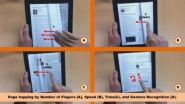(Press-News.org) A UC Davis graduate student who is leading a study of the collision of galaxy clusters 5 billion light years away will discuss the team's findings today, Jan. 10, in a press briefing at the annual meeting of the American Astronomical Society in Austin, Texas.
"A galaxy cluster is like a little universe, because it has the same matter composition as the whole universe," said William Dawson, a Ph.D. candidate in physics. "By studying this little universe, we can learn more about our own."
This "little universe" is formally called DLSCL J0916.2+2951 and consists of two clusters of hundreds of galaxies each, in the process of merging into one.
It is nicknamed Perry's Cluster, after team member Perry Gee, a UC Davis research scientist who discovered it. It is similar to another merging cluster — the Bullet Cluster — but relatively further along in its development.
Perry's Cluster comprises about 86 percent dark matter, 12 percent superheated gas and 2 percent actual stars. Those proportions are similar to the distribution of mass in the universe as a whole, Dawson said.
Dark matter is thought to interact very little, if at all, with "regular" matter and does not emit light. But it does exert a gravitational pull on light passing through or near it, distorting the image of distant objects — rather like looking through the bottom of a glass bottle.
Dawson and colleagues mapped the visible galaxies in Perry's Cluster by using the Hubble Space Telescope, the 8-meter Subaru Telescope in Hawaii, the 4-meter Mayall Telescope at the Kitt Peak National Observatory in Arizona and the twin 10-meter telescopes at the W.M. Keck Observatory in Hawaii, and the orbiting Chandra X-ray Observatory for the super-hot gas.
And, with the Hubble, Subaru and Mayall telescopes, the researchers mapped the dark matter by observing distortions in light passing through the cluster from more distant objects — a method called weak gravitational lensing.
The map revealed that the two galaxy clusters within Perry's Cluster had passed through each other — the spaces between the galaxies within the clusters are so vast that actual collisions are unlikely — and that most of the dark matter also had passed through without collision.
Not so with the gas clouds — they had collided and become stuck between the clusters, making a huge cloud of gas a thousand times hotter than the surface of the Sun.
"Because these mergers separate the various matter components of the cluster, they provide astronomers with dissection of the cosmos that would otherwise be impossible," Dawson said.
By comparing and contrasting the behavior of the dark matter to that of the galaxies and gas in the merging cluster, physicists can rule out some theories about dark matter's properties.
The energy of these merging clusters is incomprehensibly large, Dawson said — a million-million times bigger than a supernova. Only a handful have been studied to date.
The cluster is the most advanced of these merging clusters yet seen, Dawson said. Every great advance in our understanding of the physical world is the direct result of understanding how things change with time, so the hope is that by observing clusters at different stages of merging, astronomers can gain insight into the physics involved, he said.
INFORMATION:
UC Davis colleagues who joined Dawson in his work include Associate Professor David Wittman; project scientist M. James Jee; Professor J. Anthony Tyson; postdoctoral researchers Samuel Schmidt, Paul Thorman and Brian Lemaux; and Assistant Professor Marusa Bradac.
Other team members: John Hughes of Rutgers University; Satoshi Miyazaki and Yousuke Utsumi of The Graduate University for Advanced Studies Tokyo; and Vera Margoniner, California State University, Sacramento.
The National Aeronautics and Space Administration supported the work through the Chandra X-Ray Observatory Center and through a grant from Space Telescope Science Institute.
END
For immediate release - January 10 - (Toronto) – In a new study from the Centre for Addiction and Mental Health (CAMH), people with schizophrenia showed greater brain activity during tests that induce a brief, mild form of delusional thinking. This effect wasn't seen in a comparison group without schizophrenia.
The study appears in the December issue of Biological Psychiatry.
"We studied a type of delusion called a delusion of reference, which occurs when people feel that external stimuli such as newspaper articles or strangers' overheard conversations are about them," ...
Handball is one of the top four sports, at least as far as the risk of injury is concerned. In particular, the jump shot frequently causes sprained ankles, tears to the ligaments connecting the bones of the foot and the lower leg. One of the goals of sports science is to minimize sporting injuries while also improving performance. To this end, many trainers and sports scientists are making increasing use of hi-tech methods, such as the computer modelling of moving joints.
Virtual ankle
To understand why the ankle is so prone to injury during the jump shot, a team ...
Countless mice, rats and rabbits die every year in the name of science – and the situation is getting worse. While German laboratories used some 2.41 million animals for scientific research in 2005, by 2009 this number had grown to 2.79 million. One third were destined for fundamental biology research, and the majority were used for researching diseases and developing medical compounds and devices. People demand medicines that are safe and therapies that are tolerable, but hardly anyone is happy to accept the need for animal testing. This is why scientists have spent years ...
A group of experts has prepared a report on vitamin D supplementation for menopausal women after it was revealed that Europeans have suffered an alarming decrease in their levels of this vitamin. In their opinion, the ideal would be to maintain blood levels above 30 ng/ml. Vitamin D is essential to the immune system and processes such as calcium absorption.
"We believe that many diseases can be aggravated by a chronic deficiency of vitamin D," states Faustino R. Pérez-López, researcher at the University of Zaragoza. In particular, this is worse during the menopause as ...
Total Mortgage Services, LLC, a leading mortgage lender, announced today the hiring of Neil Bader as the Company's National Retail Sales Manager. To this important management position, Mr. Bader brings more than 25 years of production, leadership, and entrepreneurship within the mortgage industry. In his new role, Mr. Bader will be responsible for expanding Total Mortgage's successful retail channel, as it continues its nationwide growth. Mr. Bader will be based in Milford, Connecticut and report directly to John Walsh, President of Total Mortgage.
"Neil is a focused ...
Daejeon, Republic of Korea, January 10, 2012—Korea Advanced Institute of Science and Technology (KAIST) announced today that its research team headed by Professor Howon Lee from the IT Convergence Research Institute has developed a technology that will make reading on smartphones and tablet PCs easier than now.
The technology, called the "Smart E-book System," allows users of smartphones and tablet PCs to effortlessly flip through the pages of an e-book or cross-reference its contents, just as they would with paper-based books and magazines.
Unlike conventional displays ...
A new study supports previous findings that children delivered by cesarean section have an increased risk of developing asthma.
The study from the Norwegian Mother and Child Cohort Study (MoBa) suggests that children delivered by cesarean section have an increased risk of asthma at the age of three. This was particularly seen among children without a hereditary tendency to asthma and allergies.
Data from more than 37 000 participants in the MoBa study were used to study the relationship between delivery method and the development of lower respiratory tract infections, ...
Fusion plasma researchers at the University of Warwick have teamed up with Cambridge neuroscientists to apply their expertise developed to study inaccessible fusion plasmas in order to significantly improve the understanding of the data obtained from non-invasive study of the fast dynamics of networks in the human brain.
Unless they undertake invasive techniques, neuroscientists are limited to external sensing when studying live brains. One key method the researchers turn to is magnetoencephalography (MEG) in which sensors measure the tiny magnetic fields outside the ...
A new study by Rice University's Baker Institute for Public Policy illustrates a disconnect between government funding of biomedical research by young investigators and a novel standard by which to judge it: the Nobel Prize.
The study found the average age of biomedical researchers getting their first grant from the National Institutes of Health (NIH) in 2008 was 42. Over the past 30 years, the average age of Nobel winners when they performed their groundbreaking research was 41.
That should trouble those concerned about the United States' standing as a biomedical powerhouse, ...
Researchers at Linköping University in Sweden are now launching a plan to effectively treat psoriasis.
An estimated 125 million people worldwide suffer from the difficult to treat disease, which manifests itself in scaly and often itchy patches on the skin. The reason is that cells divide without restraint as new blood vessels form in the deeper layers of the skin.
An important component is the psoriasin protein (S100A7), which are abundant in psoriasis-affected skin but rarely in normal skin. The same protein is also assumed to be a factor in the development of breast ...



